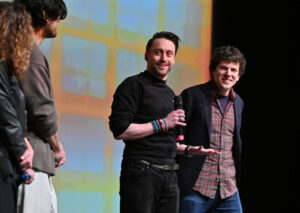Stacy Peralta, director, Bones Brigade: An Autobiography
Stacy Peralta is an American filmmaker, former professional skateboarder, and original member of the Z-Boys. He joins Film Forward in Imperial Valley to screen and discuss his latest film ‘Bones Brigade: An Autobiography.’ Read Stacy’s previous blogs here and here.
Friday, March 1
This is the last day of our Film Forward trip, we’re off this morning to once again climb the big fence for Mexicali: I’m with Jerry, Meredith, Bethany, Marco, Reuben, and Stephanie.
We are spending the early part of the morning back at UABC. But this time we’re switching it up. The students are going to show Jerry and I their films and the dialogue will be about their work. About thirty students show up in the school’s theater and the group is led by their writing professor Alejandro Espinoza Galindo.
The students’ films are all shorts and range in genre from Mexican Zombie to drama to cinematic poetry to documentary portrait. Each of the filmmakers has been asked by their instructor to stretch and search, to experiment and to be willing to take chances even if that means falling on their faces. I can’t agree with him more, I know intimately and by decades of experience how important it is to understand failure and obstacle as an artist, especially as a young artist. Understanding failure and setback might just be the most important skill in becoming successful.
First up is a Mexican Zombie film, the young director tells us he made it because he wanted to see if he could pull off extreme effects in make-up on a no student-budget-production – he actually pulled it off. Jerry and I then discuss with him the merits of his current storytelling abilities; storytelling being the one aspect we keep hitting them with, nothing is more important than story. You can shoot well, direct well, produce well but if you don’t have a compelling story nothing else will matter.
Having been on the receiving end of the “Hollywood notes” process for many years through the making of television and then many films – I am mindful of the power of feedback, the subtleties of tone and word choice and am empathetic with these young directors as they courageously present their work, ask questions and listen carefully to comments. There’s nothing that can derail a filmmaker faster than an off-handed criticism lobbed from left field. Having had my head torn off many times by totalitarian executives, I’m eager to be vigorously helpful yet gentle.
One constant we see in all the directors whose films we watch is drive combined with curiosity. Each director is a uniquely different type of storyteller that reminds me of the unlimited alchemy of making movies. Jerry and I tag-team in deconstructing the film making process and the process of how to go about making a career in today’s film world – both of us are acutely aware of how important it is to these students for them to know they too “can do it,” they can make it happen and that is a mantra we keep repeating to them.
Each person in our Film Forward group participates in the conversation here so I think the students get a lot to think about as they move forward in their creative journeys.
The UABC ends up being a very engaged visit and we end up going long on time and we don’t want to be late for our next session which is at Mexicali Rose Media/Arts Center. There we will find another group of young filmmakers who are under the mentorship of our primary guide Marco Vera.
BUT, we promised Jerry and Bethany the famous Mexicali tacos we all had a few days ago so we’re in a quandary about how to make it all happen in a short window of time. Marco shouts, “Take out”! Once we get to Mexicali Rose, Bethany heads out with Alicia, one of the Mexicali Rose filmmakers, to get the tacos and the accompanying array of requisite condiments.
The Mexicali Rose headquarters is a humble house, painted a deep cobalt blue and resides in a very unusual neighborhood. Most of the houses here are small, some are in decent shape and some, in fact many are completely burned out as if they’d been hit by a drone strike. The mixture is odd and so wonderfully strange.
The space inside Mexicali Rose is resourced with found and rummaged tables, chairs and desks – all mismatched but fine nonetheless. There are make-shift editing rooms with equipment dating back to early computer monitors and tape – plus computers of varying eras. There’s a library with how-to books and DVDS in a small loft like room upstairs. It’s all very clubhouse in tone and style and function. Out back is a beautifully swept desert garden with raw bentwood chairs and wood tables.
Next door is a desert garden which has been created and is maintained by Marco’s father. He’s there now with a rake, so we introduce ourselves and tell him how much we admire his garden. He says with a wink, “It is Mexican style…like me.”
We all recline for a moment in the breezy shade of the backyard until the tacos arrive. A feeding frenzy erupts. They are just as good if not even better the second time.
There are about a sixteen of us with all the filmmakers in Marco’s group and after lunch we sit in the makeshift screening room of white molded plastic garden chairs and watch their short films projected onto a white stucco wall.
Most of these young people are making documentaries. Alicia’s is a portrait of a male transvestite performer. Alicia has found a compelling and articulate subject to be the focus of her film and she has framed him beautifully in his dressing room preparing for the night’s performance. Another filmmaker experiments with overlays of sound design and visuals – having recorded the sounds of a small Mexican town and sunk it up incongruously with a wide shot of two kids dirt-biking in a lot with a terrified brown pony chasing after them. This tweaked and ironic slice of life makes a really watchable piece of filmmaking. Another filmmaker has created a visual tapestry out of fast motion city footage cut with ambient jazz to create an almost hallucinatory visual of traveling through a modern city. What Jerry and I notice about all of these filmmakers above everything else is their all important point-of-view. They have a point-of-view and we compliment them on this, how important this is and we urge them to continue developing this aspect of their art – as there is perhaps nothing more important to their budding careers, artistically speaking then their own point-of-view and what they bring forward from within themselves.
We are running late again and have to cut through Mexicali rush hour traffic to make it to IIC Museo – UABC. Jerry will have the final showing of his film this afternoon to an audience of about 200 followed by a Q&A. The front row of the audience is made up of children ranging in age from elementary through middle school. Town of Runners has gotten a fantastic reception here and the Q&A is lively and involved. Check out Jerry’s blog post about this.
A Chinese food dinner follows Jerry’s screening. One thing Marco has been raving about and promising us, aside from the amazing tacos, is the Mexicali Chinese food. Having a large Chinese population for decades now has created a large number of Chinese food restaurants in Mexicali and we are taken to the one considered the best – Golden China Restaurant. It’s quite ornate, lots of gold and white decorations with finely attired waiters and many of them. Marco does the ordering and 45 minutes later we are once again in full abdominal pain from consuming another ridiculously spectacular meal. Afterwards we bid farewell to Charla Teeters who is heading back across the border to El Centro. Charla has rallied the Imperial Valley – every corner of it, it seems — and hooked us up with some great street-level screenings. We are grateful for her enthusiasm for the Film Forward program.
Now it’s off to the Casa de La Cultura center – one of the oldest buildings in Mexicali. This will be the last and final screening of my film on this leg of the Film Forward adventure. We arrive to find the place packed, something like six to eight hundred people are sitting in an outdoor screening area right next to the huge fence that demarks Mexico from America. The director of the Casa de La Cultura, Leticia Maldonado, is a five foot tall red-headed middle-aged woman who fires up her audience as if she is a rock concert impresario. The audience is made up of middle-age folks, street artists, movie buffs and skateboarders with boards in tow. It’s a form of happy mayhem as these kids skate around the grounds of the cultural center while the film plays; ollieing down stair wells, murching along the sidewalks and just creating physical madness, another sign of how the Mexican culture understands the importance of street culture. The entire tableau is like a punk Diego Rivera.
It’s now late and we finally get back to the van and it is time to bid farewell to Marco, who we are sure to see sooner than later as he has a trip planned to LA. We look forward to introducing him to some of the street artists we know.
The trip across the border takes about 45 minutes. The “My Three Sons” band is there, but the father has been replaced with what looks like another brother. We see a teenage girl who looks as if she should be home doing homework. She’s not selling anything and we wonder about her story…but don’t ask. A very different experience of isolation from the week we’ve just had where the questions flowed freely back and forth and the fences were all knocked down.
Saturday, March 2
After purchasing coffee from the Starbuck’s next to our hotel, Meredith hops in our car with Stephanie and I, Jerry with Bethany. On the ride back to LA Meredith gets to see the fantastic rock landscape she had missed on the way out to Imperial Valley, as it had been dark. The place is beautiful and haunting, like something out of the Twilight Zone. On the car ride the three of us talk about how on this trip we got to experience the mandate of Film Forward – to hop fences and connect with people and to share – which is what we did; everywhere we travelled, we hopped over cultural fences and we showed our films – in each new location we were met with people who were eager for new experience and were eager with questions, who were hungry for answers and inspiration and who wanted to take part and connect. All of the students we met along the way want to believe they can follow their own dreams, much as we have followed ours. This was one of the most discussed topics – following dreams. Specifically, “Can I follow my dreams coming from the remote place where I live?” As filmmakers along this journey also, we shared with them our struggles and obstacles, trials and tribulations and all the roads we’ve travelled and in the end, somehow we were all coming from the same place and going to the same place regardless of our physical boundaries, regardless of the fences we had to hop and will have to hop.
The Film Forward program is one of those lofty concepts that sound good on paper and sounds even better in conference rooms. But does it pass the concept stage and work in practicality? We found it did work and it worked better than any of us could have imagined because it not only affected the students and young filmmakers and artists and community members and those who came to participate in it, but it affected us as well. It showed us a world we have never seen before and it connected us with people we might never have met or connected with.
We all want to believe that art bridges divides, crosses boundaries and connects people – and in this wired digital age, with everything at our finger tips, this crazy street level idea called Film Forward, with a mandate to culturally hop fences and cross pollinate people with people ended up working, at least for this filmmaker it did and I believe it worked for all of those I met along the way and for our entire team. It was non-digital, totally analog, down and dirty and carried out on the most basic gut level; eye to eye, hand shake to hand shake and hug to hug and it worked. We connected and we shared and we all walked away feeling closer to the dream. It was very real. I’m grateful to have taken part.
So if you’re curious and you want to know more, please find a fence to hop, reach out and connect with someone who’s posted a video or piece of art – start a conversation, make a new friend, share something you know with someone you don’t.
I’ll see you in September when we’re off to the Film Forward leg in Bosnia & Herzegovina. So check back.




